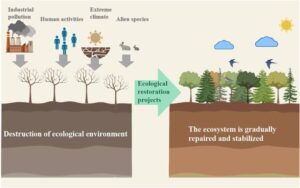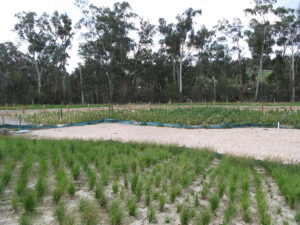Back to: Botany 500 Level
My Afrilearn champion, how far?
I dey happy to see you back for this next lesson, because today we go talk about something wey dey very important for our environment—Restoration Ecology. This topic na about how we fit repair and restore damaged ecosystems. You know how sometimes if person break something, dem go try fix am back to how e be before? Na so restoration ecology be, but we dey fix nature after human activities or natural disasters don damage am.
Restoration ecology
Wetin Be Restoration Ecology?
Restoration ecology na the branch of science wey focus on returning damaged or degraded ecosystems back to their natural state. Sometimes, nature fit heal by itself, but other times we need human help. Think of it like when rain comes after dry season to bring life back to the land, or when people replant trees after a forest fire. The goal is to bring back biodiversity, restore natural processes, and make sure the ecosystem fit function well again.

Why Restoration Ecology Dey Important?
- Protect Biodiversity: It helps to bring back plants, animals, and other living things wey fit be in danger of extinction.
- Improve Ecosystem Services: Restoration helps ecosystems like forests and wetlands provide things we rely on, such as clean air, water, and food.
- Climate Change Mitigation: By restoring forests and grasslands, we help absorb carbon dioxide, reducing climate change.
- Prevent Further Damage: If we no restore damaged ecosystems, dem fit cause bigger environmental problems, like soil erosion, desertification, or flooding.
Methods of Restoration Ecology
There are different ways to restore ecosystems, and the methods depend on what has happened to the environment.
- Reforestation and Afforestation:
This involves planting trees where they have been cut down or lost. For example, if people cut down trees for timber or farming, replanting those trees helps restore the forest. - Wetland Restoration:
If wetlands like mangroves or swamps are destroyed, we can restore them by planting native plants, clearing debris, and controlling water levels to bring the wetland back to life. - Soil Restoration:
If soil has been over-farmed or eroded, we can restore it by adding organic matter, planting cover crops, and preventing further erosion. This helps the soil recover its fertility and structure. - Invasive Species Control:
Sometimes, non-native plants or animals invade an ecosystem and cause harm. For example, if an alien plant species takes over a forest, the native plants suffer. Removing or controlling these invaders is an important step in restoration. - Ecosystem Function Restoration:
This means reintroducing natural processes like water cycles, nutrient cycling, and predator-prey relationships. If a forest has been destroyed, bringing back animals like elephants or bees could help the ecosystem recover its original balance.
Imagine you have a community farm, and because of farming, the soil don become weak, and crops no dey grow well. If you plant cover crops like legumes, which help add nutrients to the soil, and add organic matter like manure, the soil will improve over time. That’s a form of soil restoration. Also, say you replant trees in the forest to stop erosion—this go help restore the forest and prevent flooding. Na this kind small-small work wey fit bring big change.

Case Study – Restoration of the Niger Delta
The Niger Delta area has suffered a lot of environmental damage due to oil spills and gas flaring. Restoration projects in this area include planting mangrove trees to prevent coastal erosion, cleaning up oil-polluted soils, and encouraging local communities to protect the environment. These efforts help restore ecosystems and support the livelihood of the people who depend on them.
Challenges in Restoration Ecology
- Funding: Restoration projects can be expensive, and getting money for these projects can be difficult.
- Lack of Awareness: Some people may not understand the importance of restoration, so they may not support or participate in efforts.
- Climate Change: Sometimes, climate change itself can make restoration harder because weather patterns are changing, making it difficult to predict or manage the restoration process.
- Time: Restoration can take a long time. Nature no dey heal quickly, and some ecosystems may take decades to fully recover.

Summary:
- Restoration ecology focuses on bringing back damaged ecosystems to their natural state.
- It helps protect biodiversity, improve ecosystem services, and mitigate climate change.
- Methods include reforestation, wetland restoration, soil restoration, and invasive species control.
- Despite challenges like funding and climate change, restoration ecology is crucial for a sustainable future.
Evaluation:
- What is restoration ecology?
- List two methods used in restoration ecology.
- Why is restoration of the Niger Delta important for Nigeria?
Afrilearn star, you too much!
Your understanding of nature just dey increase, and I know say you go use this knowledge to make real change for Nigeria and Africa. The environment needs champions like you, so keep learning and stay inspired! Let’s get ready for the next lesson, because the journey no dey stop!
